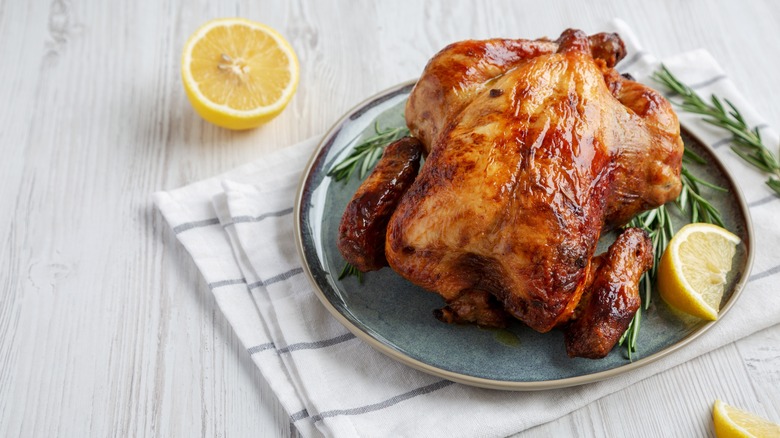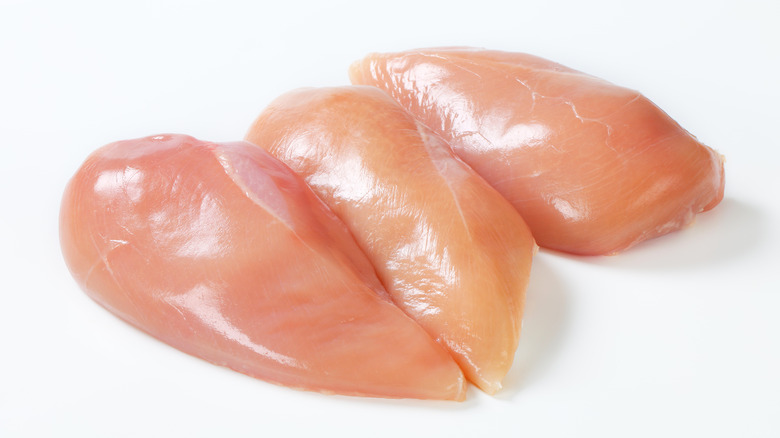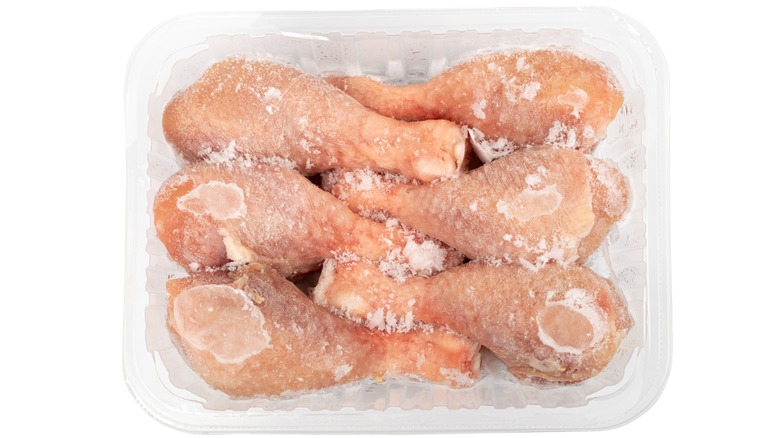Is It Safe To Eat Chicken That's Still Pink After Cooking?
The dangers of undercooked chicken are a significant concern in the kitchen. Chicken is one of the foods most likely to give you salmonella, and the Centers for Disease Control and Prevention estimate that one million Americans get food poisoning from poultry every year. Thoroughly cooking chicken is essential for your health (not to mention its taste and texture), but you might not be judging its doneness as accurately as you think. Our experiences with beef and lamb teach us that the color of meat is a surefire indicator of its doneness. The pinker the meat, the closer it is to raw. It's natural to assume that this rule applies to every type of meat, but that's not entirely true when it comes to poultry.
Just because chicken meat is pink doesn't necessarily mean it's undercooked. Pink chicken can be dangerous to eat sometimes, but there are other occasions where it's perfectly fine. Temperature determines the doneness of meat, but other factors affect its color. The age of the chicken, the way it was fed and slaughtered, the method of cooking you use, and whether the meat is white or dark all impact the meat's hue. These additional factors do not have a bearing on the safety of the meat, and thus, color is not an accurate way to judge your risk of food poisoning.
What makes chicken pink in the first place?
The color of meat is mainly determined by a protein called myoglobin. You know the pink puddle you often see in packages of raw meat? Many people assume it's blood, but it's actually myoglobin mixed with water. This combination, known as myowater, is what chicken juice is made of. If the myowater runs pink, it means it has a higher concentration of myoglobin. Additionally, the difference between white meat and dark meat is that legs and thighs have more myoglobin than chicken breasts.
When myoglobin is exposed to high temperatures, its molecular structure changes, reflecting light differently. This process, called denaturing, changes its color from pink to clear. It can take as little as 140 degrees Fahrenheit for myoglobin to denature or as much as 180 degrees. However, the Science of Cooking explains that salmonella and E. coli cannot survive beyond 165 degrees. That means chicken meat and its juices can remain pink even after any bacteria has been killed.
Many things affect the rate at which myoglobin changes color. For example, the higher concentration of myoglobin in dark meat means it is more likely to stay pink even when fully cooked. The pH level of the meat, which is affected by genetics and the potential stress caused by poor living conditions and slaughtering methods, also matters. The higher the pH, the more temperature it takes for myoglobin to turn clear.
Other factors that determine the color of chicken
Myoglobin is not the only thing that makes chicken pink. A small amount of the color is due to another protein called hemoglobin. The way you cook your chicken has a significant impact on hemoglobin. The gasses produced by ovens cause chemical reactions with hemoglobin and myoglobin that make it pink. These same chemical reactions are why barbecued meats have a red smoke ring.
Chicken meat is particularly affected by ovens and barbecues because chickens are typically slaughtered at 6-8 weeks old, at which point they have very little fat beneath their skin. This makes it easier for gasses to penetrate the meat. There's another reason that young chicken meat can appear pink. Their bones have not fully hardened at that age, and some bone marrow can leak out into the meat, making it look bloody. This is even more likely to happen if the chicken has been frozen because ice crystals can cause bone cracks.
There is only one way to accurately determine whether chicken is safe to eat: by checking its temperature. Color is not a direct indicator of temperature, so you can't make an accurate assumption of it based on pinkness. You need to use a meat thermometer. The CDC states that chicken should be cooked to 165 degrees Fahrenheit to ensure no potentially harmful bacteria can survive. This easy and reliable step can make the difference between a delicious meal and a gastrointestinal disaster.


